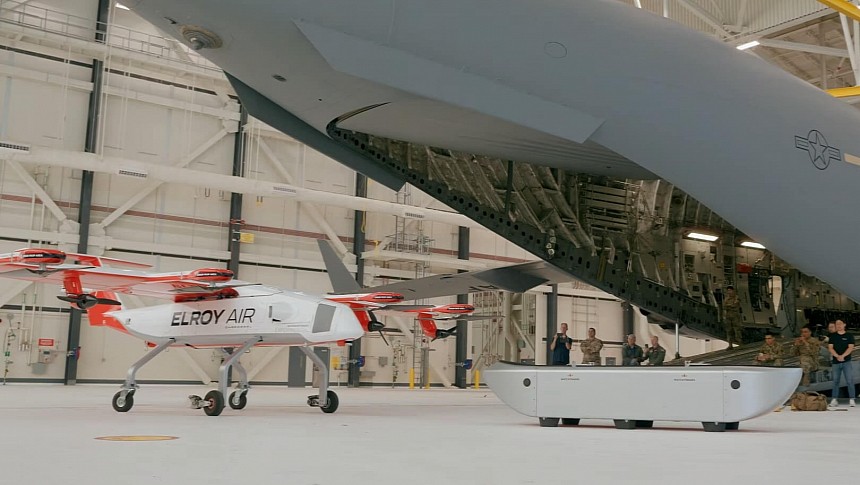Logistics experts agree that self-flying drones are a key element of future operations, not just for their zero-emissions potential but also for new levels of speed and efficiency. When it comes to the military, autonomous solutions like the Chaparral are expected to work side by side with mainstream cargo giants like the C-17 Globemaster.
This year's Mobility Guardian, a large-scale Air Mobility Command (AMC) readiness exercise, included a demonstration that illustrates what future cargo operations could look like. It involved a C-17 aircraft and a Chaparral eVTOL (electric vertical takeoff and landing) developed by Elroy Air.
The C-17 is a Boeing-made military transport aircraft of enormous proportions. It combines a wingspan of more than 169 feet (52 meters) with a 55-foot (17 meters) height. Powered by four Pratt & Whitney engines and boasting a maximum payload of 585,000 lbs (265,352 kg), it was designed to carry huge quantities of supplies or to transport troops over great distances. With the help of aerial refueling, the C-17 can literally travel the world at a high speed of more than 518 mph (834 kph), and it's been doing so for decades.
The Chaparral cargo eVTOL, on the other hand, is much younger. Elroy Air, a California-based startup, unveiled the pre-production version at the beginning of last year. Chaparral C1 is an advanced delivery drone claiming to offer both a longer range and generous payload. Its main innovation is a modular cargo pod with an unusual aerodynamic shape that makes it look similar to a boat.
This eVTOL owes its efficiency to an automated process. Although personnel on the ground needs first to load the pod, the drone can then pick it up autonomously and take off. The entire process of landing, picking up a newly loaded pod, and taking off is done in only a few minutes. Plus, no human intervention is required throughout any of these steps once the pod is loaded.
Propulsion-wise, Chapparal C1 is actually a hybrid-electric vehicle, which enables it to cover up to 300 miles (482 km) while carrying a considerable payload of 500 lb (226 kg). At the same time, thanks to its automated capabilities, it claims to deliver cargo five times faster than a conventional truck.
During this recent demo, Chaparral got to show what it can do in conjunction with the venerable C-17. This included loading and deploying the eVTOL from the cargo aircraft, locating and picking up cargo pods, autonomous taxiing, and delivering the cargo pods.
This is just one step towards the future integration of Chaparral with the existing US Air Force logistics systems. Following this successful demo, the Californian company will keep working with various USAF teams on the best ways to operate Chaparral in order to take military logistics to the next level.
The C-17 is a Boeing-made military transport aircraft of enormous proportions. It combines a wingspan of more than 169 feet (52 meters) with a 55-foot (17 meters) height. Powered by four Pratt & Whitney engines and boasting a maximum payload of 585,000 lbs (265,352 kg), it was designed to carry huge quantities of supplies or to transport troops over great distances. With the help of aerial refueling, the C-17 can literally travel the world at a high speed of more than 518 mph (834 kph), and it's been doing so for decades.
The Chaparral cargo eVTOL, on the other hand, is much younger. Elroy Air, a California-based startup, unveiled the pre-production version at the beginning of last year. Chaparral C1 is an advanced delivery drone claiming to offer both a longer range and generous payload. Its main innovation is a modular cargo pod with an unusual aerodynamic shape that makes it look similar to a boat.
This eVTOL owes its efficiency to an automated process. Although personnel on the ground needs first to load the pod, the drone can then pick it up autonomously and take off. The entire process of landing, picking up a newly loaded pod, and taking off is done in only a few minutes. Plus, no human intervention is required throughout any of these steps once the pod is loaded.
Propulsion-wise, Chapparal C1 is actually a hybrid-electric vehicle, which enables it to cover up to 300 miles (482 km) while carrying a considerable payload of 500 lb (226 kg). At the same time, thanks to its automated capabilities, it claims to deliver cargo five times faster than a conventional truck.
During this recent demo, Chaparral got to show what it can do in conjunction with the venerable C-17. This included loading and deploying the eVTOL from the cargo aircraft, locating and picking up cargo pods, autonomous taxiing, and delivering the cargo pods.
This is just one step towards the future integration of Chaparral with the existing US Air Force logistics systems. Following this successful demo, the Californian company will keep working with various USAF teams on the best ways to operate Chaparral in order to take military logistics to the next level.






